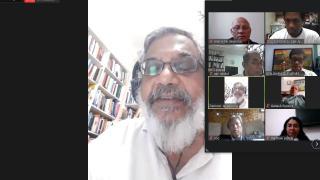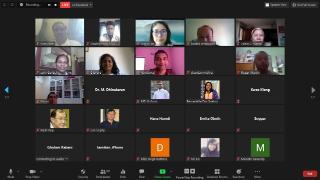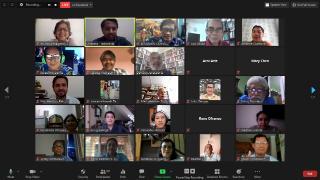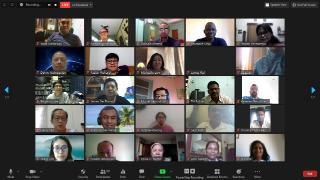ASEC Online SSE Academy (May - July 2020)
Presentations and videos
Introduction
Creating an online community in Asia by Dr Denison Jayasooria
Presentations of SSE principles
[ASEC SSE Academy] Introduction to ASEC and to Social Solidarity Economy (SSE)
[ASEC SSE Academy] SSE Dimensions 1 & 2 Socially Responsible Governance & Edifying Ethical Values
[ASEC SSE Academy] SSE Dimensions 3, 4, 5 Triple Bottom Line
[ASEC SSE Academy] Links between SSE & SDGs SSE as a vehicle for achieving the SDGs
See also videos : [ASEC SSE Academy] Session 1 : Introductory to ASEC and to SSE as social system and [ASEC SSE Academy] Session 2 : SSE dimensions no. 1 & 2 by Dr Benjamin Quinones Jr
See also videos : [ASEC SSE Academy] Session 3 : SSE dimensions no. 3, 4, 5 by Datuk Dr Denison Jayasooria and [ASEC SSE Academy] Session 4 : Linking SSE to SDGs by Datuk Dr Denison Jayasooria
See also videos : [ASEC SSE Academy] Session 5 : Networking & Communication by Chandra Firmantoko and [ASEC SSE Academy] Session 5 b : Networking & Communication by Dr Eri Trinurini
Case studies
Summary of Case Studies of ASEC SSE Academy
by Eri Trinurini Adhi
“Self-reliant, self-sufficient and self- manage: Village Republic (the mission of ASSAFA)”
It has been 13 case studies from 6 countries in Asia presented during the 5 sessions of ASEC SSE Academy (2-29 May 2020). The case studies have been highlighted the practices of 5 dimensions of Social Solidarity Economy: social responsible governance, edifying values, community social economy benefit, ecological conservation and economic sustainability. Besides, in the presentation most of the presenters is also ask to share the effort and impact of the covid-19 to the community. In each presentation at least 2 aspects has been explained: 1) about the NGO it self, who are they and what vision and mission and 2) about the community project. Related to the organization/NGO types, at least there are two types of organization or NGOs as presenters, first is NGO who get the funding from donor or other sources to fund the community project and the second type is social enterprise which integrate the community project within the core business. From the 13 presenters, 10 organizations are NGO types and 3 organizations (Bina Swadaya/Indonesia, Sarvodaya/Srilanka, ASSEFA) are social enterprises. However, presentation are very interesting and represent the issues in the urban and rural areas and different sectors such as manufacture, agriculture, social media and health/sanitation.
I am impressed with all presentations. It shows that all the organization/presenters are working with their passion to and with the community. Though the project might be funded by external sources, but all the projects are people driven oriented. The project strategies and implementations are based on the people need, no wonder if they can provide economic benefit for the community, peacefully and harmony in the society and economic sustainability. Behind all these success, there are a passionate community facilitators, NGO managers and other SSE practitioners. Among the presenters, there is Homenet Thailand, which is quiet advance in doing the advocacy to the local government. I am impressed also with the ASSAFA, which is successfully scale up the community empowerment to the level of village economy, with the integrated business in form of collective ownership. Related to the economic sustainability, the presentations has shared the importance role of women as the key factor in bringing the community project sustainable. There is an interesting questions from Prof Dr Rosalinda Ofreneo on how far the economic activities has help the women in the domestic role? The women participation should then more comprehensive assessed and approach by involving men and women in the process to pursue gender equality. I was also impressed with the presentation from Habitat which using the technology (e-money card) to manage the community toilet. It shows that the technology can be a good tools to accelerate the community empowerment and SSE mission.
The 15 minutes presentation was too short to understand the complex problem and approach and solution of case studies. We don’t have time to listen the threats and opportunities to widen their impact. As we are living in the capitalist system, we need to aware and be prepared to coop with the existing system. Regardless the good impact has been delivered to community, the challenge is also how to bring the NGOs more economy sustainable, that means practising the 5 dimension in the management of organization.
See also the - [ASEC SSE Academy] Reflections on the SSE case studies featured in the ASEC SSE online Academy By Dr. Benjamin R. Quiñones, Jr.
You will find here the presentations :
[ASEC SSE Academy] : People-oriented economy. Parnaama Development Foundation, New Dehli, India
[ASEC SSE Academy] : 4P Model in Urban Sanitation. Building Public-Private-People(s Partnerships
[ASEC SSE Academy] Case study KG ORANG ASLI ULU Gumum, Malaysia
[ASEC SSE Academy] PATAMABA-Workers in the Informal Sector Enterprise (WISE)
[ASEC SSE Academy] Towards SSE practices of the Federation of Informal Workers of Thailand
[ASEC SSE Academy] Social and Kingdom Enterprise: Transformation of a Community
[ASEC SSE Academy] Linking Farmers and Consumers during the COVID 9 lockdown. Pakisama initiatives.
[ASEC SSE Academy] Social Solidarity Economy Sarvodaya Experience
[ASEC SSE Academy] Institute’s for Women Empowerment. Reclaiming the « I », redefining the « We »
[ASEC SSE Academy] WISHALL Women In Self Help Action in Lords Love
[ASEC SSE Academy] Jagran Jan Vikas Samiti Promoting Complementary Health Care Practices through SSE
[ASEC SSE Academy] Towards SSE with women in Informal Economy for Sustainability
Some pictures to see the participans to the webinars :





